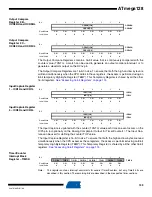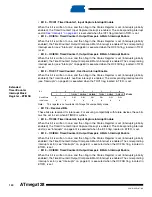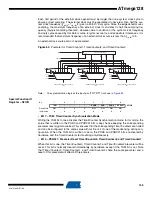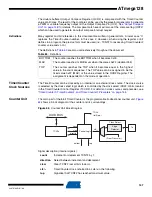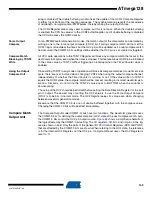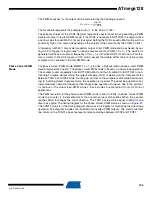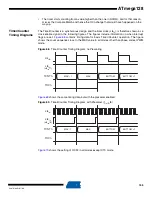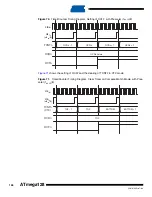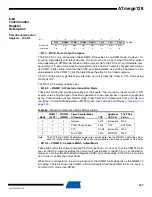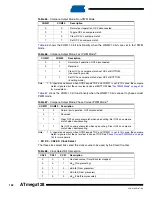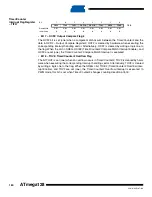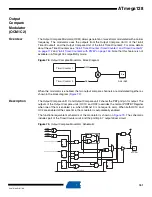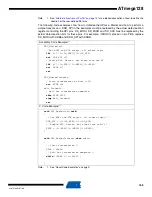
152
2467S–AVR–07/09
ATmega128
The N variable represents the prescale factor (1, 8, 64, 256, or 1024).
As for the normal mode of operation, the TOV2 flag is set in the same timer clock cycle that the
counter counts from MAX to 0x00.
Fast PWM Mode
The fast Pulse Width Modulation or fast PWM mode (WGM21:0 = 3) provides a high frequency
PWM waveform generation option. The fast PWM differs from the other PWM option by its sin-
gle-slope operation. The counter counts from BOTTOM to MAX then restarts from BOTTOM. In
non-inverting Compare Output mode, the output compare (OC2) is cleared on the compare
match between TCNT2 and OCR2, and set at BOTTOM. In inverting Compare Output mode, the
output is set on compare match and cleared at BOTTOM. Due to the single-slope operation, the
operating frequency of the fast PWM mode can be twice as high as the phase correct PWM
mode that use dual-slope operation. This high frequency makes the fast PWM mode well suited
for power regulation, rectification, and DAC applications. High frequency allows physically small
sized external components (coils, capacitors), and therefore reduces total system cost.
In fast PWM mode, the counter is incremented until the counter value matches the MAX value.
The counter is then cleared at the following timer clock cycle. The timing diagram for the fast
PWM mode is shown in
. The TCNT2 value is in the timing diagram shown as a histo-
gram for illustrating the single-slope operation. The diagram includes non-inverted and inverted
PWM outputs. The small horizontal line marks on the TCNT2 slopes represent compare
matches between OCR2 and TCNT2.
Figure 66.
Fast PWM Mode, Timing Diagram
The Timer/Counter overflow flag (TOV2) is set each time the counter reaches Max If the inter-
rupt is enabled, the interrupt handler routine can be used for updating the compare value.
In fast PWM mode, the compare unit allows generation of PWM waveforms on the OC2 pin. Set-
ting the COM21:0 bits to 2 will produce a non-inverted PWM and an inverted PWM output can
be generated by setting the COM21:0 to 3 (see
). The actual OC2 value
will only be visible on the port pin if the data direction for the port pin is set as output. The PWM
waveform is generated by setting (or clearing) the OC2 Register at the compare match between
OCR2 and TCNT2, and clearing (or setting) the OC2 Register at the timer clock cycle the coun-
ter is cleared (changes from MAX to BOTTOM).
TCNTn
OCRn Update
and
TOVn Interrupt Flag Set
1
Period
2
3
OCn
OCn
(COMn1:0 = 2)
(COMn1:0 = 3)
OCRn Interrupt Flag Set
4
5
6
7


